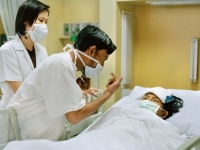especially aggressive
What is a cholera?
 Today in Yemen, the epidemic of cholera rages, the world health system headed by the WHO pays a lot of attention to this problem. This fact raises the question of what cholera is, why it is real in the XXI century and whether it is dangerous for the people of Ukraine?
Today in Yemen, the epidemic of cholera rages, the world health system headed by the WHO pays a lot of attention to this problem. This fact raises the question of what cholera is, why it is real in the XXI century and whether it is dangerous for the people of Ukraine?
Cholera: What is this illness, what are its symptoms and consequences?
Cholera is an acute, especially dangerous, infectious disease. In a short period of time, it can infect a significant number of people, causing the whole epidemic, with mortality from it reaching 50% in the absence of adequate treatment. According to WHO statistics, every year in the world 1.3 to 4 million cases of infection with cholera are recorded, with dying from 21 to 143 thousand people. Continue reading
Rabies: sources of infection, symptoms and projections
 Rabies is a deadly disease that, in almost 100% of cases, is fatal (there are only a few cases of recovery from it and it is not fully confirmed that the patient had just rabies). This is a viral infectious disease in which the human nervous system is severely affected.
Rabies is a deadly disease that, in almost 100% of cases, is fatal (there are only a few cases of recovery from it and it is not fully confirmed that the patient had just rabies). This is a viral infectious disease in which the human nervous system is severely affected.
How can you get rabies?
The rabies virus is found in the urine, saliva and tears of infected animals, after it enters the human body, it quickly infects the nervous system. A patient may have signs of cerebral edema, hemorrhage, and death of nerve cells of the spinal cord and brain.
A person can become infected with rabies from a sick animal, and both from a wild and domestic one. According to the World Health Organization, in 99% of cases, dogs are the source of infection, but cats, pigs, horses, cows, foxes, etc. can be dangerous. Continue reading
Summer without hepatitis A: jaundice prevention
 Jaundice (Botkin’s disease) or hepatitis A is a seasonal disease. It is in the summer and early autumn that infectious disease specialists report outbreaks of jaundice. Hepatitis has several types, but today we will talk about hepatitis A, which, unlike other types of the disease, is transmitted through dirty hands, unwashed vegetables or fruits, water, etc. (fecal-oral route of infection). It is in the summer, in the season of mass outdoor recreation, bathing, walking, picnics, fresh vegetables and fruits, the risk of jaundice increases.
Jaundice (Botkin’s disease) or hepatitis A is a seasonal disease. It is in the summer and early autumn that infectious disease specialists report outbreaks of jaundice. Hepatitis has several types, but today we will talk about hepatitis A, which, unlike other types of the disease, is transmitted through dirty hands, unwashed vegetables or fruits, water, etc. (fecal-oral route of infection). It is in the summer, in the season of mass outdoor recreation, bathing, walking, picnics, fresh vegetables and fruits, the risk of jaundice increases.
Symptoms of Hepatitis A: What Dangerous Disease Continue reading


